
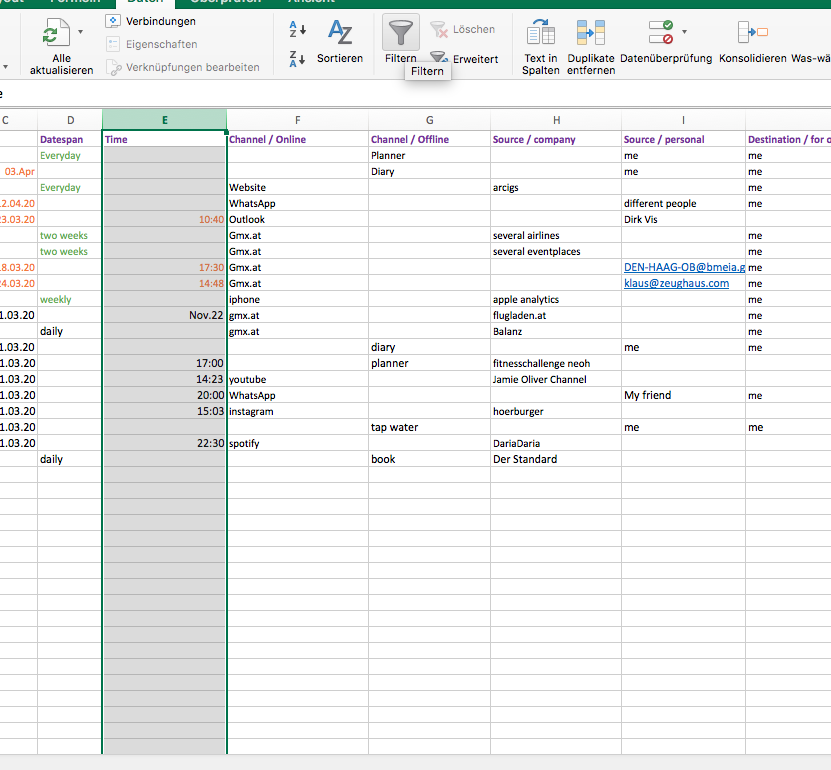
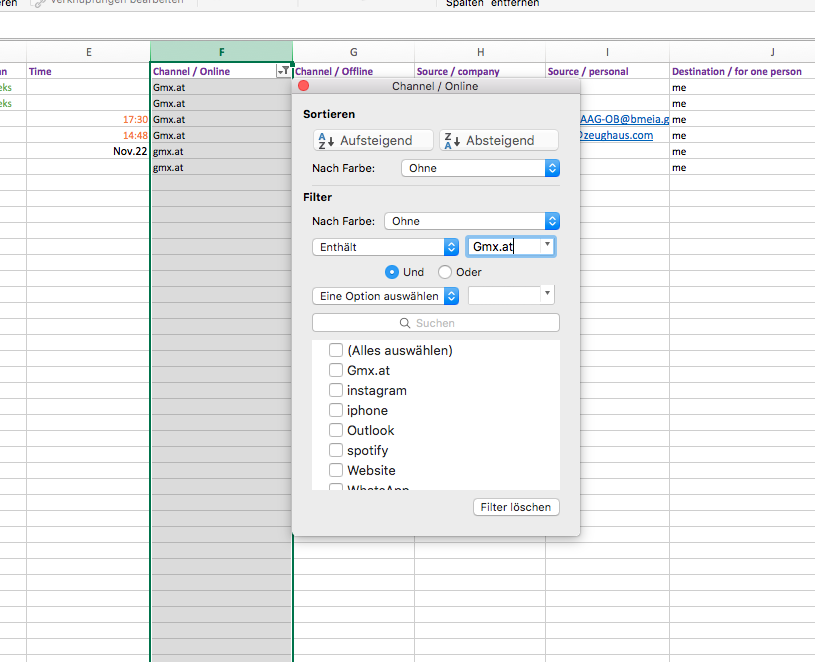
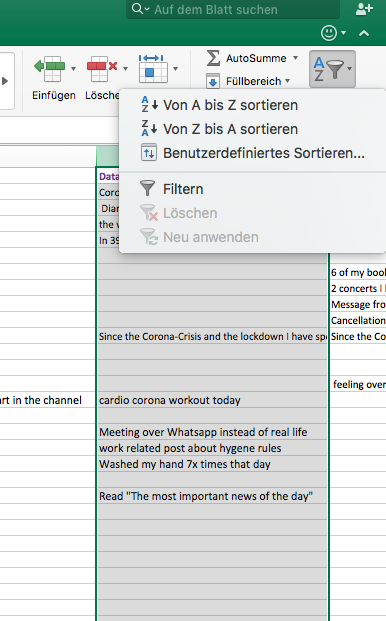

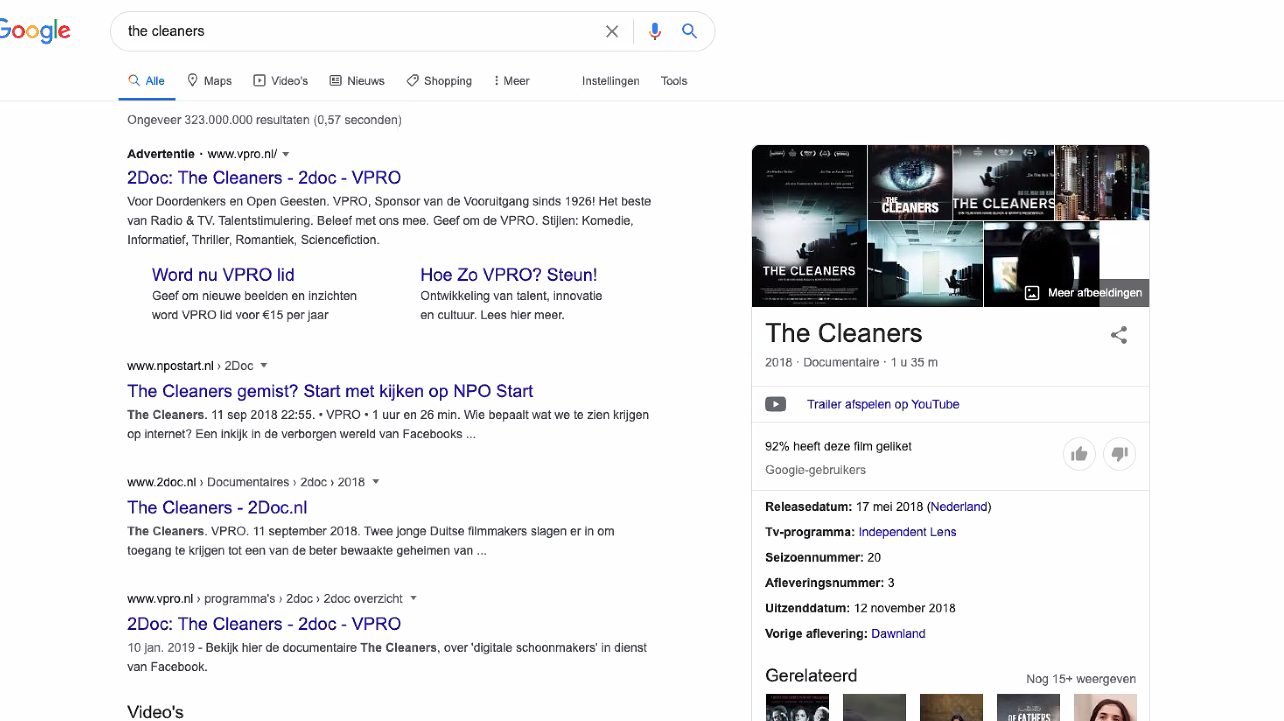
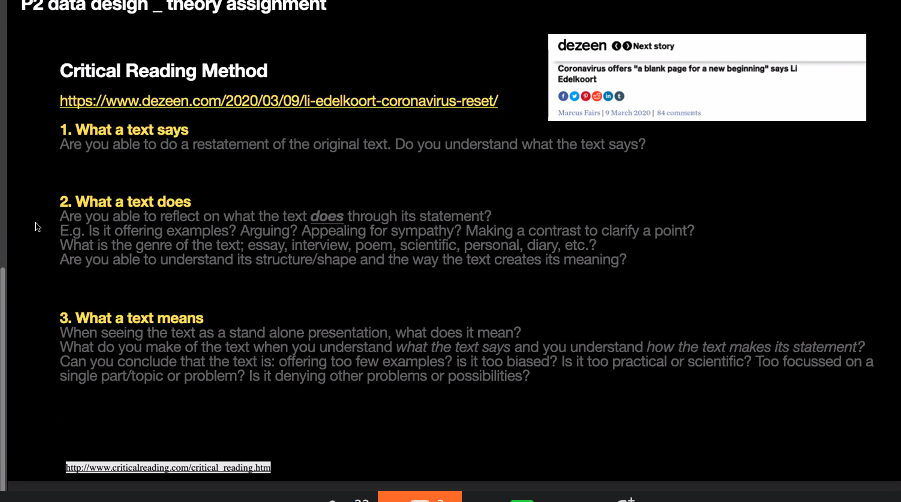
- algorithm can have good intentions but can go wrong
- they can be sexist
- algorithms are not fair because we don’t live in a perfect world
- data laundering -> hiding ugly truths
- you can’t check them for fairness
- we have to consider the long-term affects of Algorithms
- data design should be translator for ethical discussions that are happen in society
- blind faith in data must end
What the text says:
The speech is about the false trust we have into algorithms and the fact that algorithms are not fair. Algorithms decide who gets a loan, who gets a job interview, who gets insurance and much more -but they don't automatically make things fair. The speech ends with a demand for ending this blind faith in data
What the text does
The text is a Ted-Speech by Mathematician and data scientist Cathy O'Neil. It starts with an explanation of what an algorithm is and how we react towards algorithms. Then it offers insights into the ugly truths behind algorithms (Data laundering etc.)
What the text means.
The text means that we have consider the long-term affects of algorithms and we have stop believing that algorithms are fair. Only with this knowledge we can use algorithms as a translator for ethical discussions that are happening in society.
- algorithms are like virus -> can spread fast and bias
- digital mask on faces
- robots can’t detect faces of certain people
- if training sets are not diverse they can’t detect the people you didn’t feed them
- but we are feeding them with that information so we can change that
- algorithmic bias don’t always lead to a fair outcome
- Why we code matters
- Social change has to be a priority
What the text says:
MIT grad student Joy Buolamwini was working with facial analysis software when she noticed a problem: the software didn't detect her face -- because the people who coded the algorithm hadn't taught it to identify a broad range of skin tones and facial structures. Now she's on a mission to fight bias in machine learning, a phenomenon she calls the "coded gaze." It's an eye-opening talk about the need for accountability in coding ... as algorithms take over more and more aspects of our lives.
What the text does
The text is a Ted-Speech by MIT grad student Joy Buolamwini. It shows you a personal real life example of how bias Algorithms can be. It starts with her personal experience but than leads onto general observations and explanations.
What the text means.
The speech concludes that it matters why we code and what we code and that social change has to be the driving force. We have to create a world where technology works for all of us not for a chosen view. A world where technology is inclusive
- Bitcoins were supposed to be only mathematics and not touched by human thinking
- Value of a bitcoin is 22 million
- Misconception that it is lead by mathematics
- Bitcoin has a social construct it
- Yes we are giving it a value and yes we are going to put a set of rules around it
- Legitmitacy
- At the end we are dealing with human systems -> think about the human element they are not only technology
What the text says:
In a world where Bitcoin and crypto currency are essentially perceived as machine to machine interactions ,Arthur Breitman argues that while bitcoin has algorithms and mathematics ,what really makes it a network are the social constructs around it.
What the text does
The text is a Ted-Speech by Arthur Breitman. It introduces the listeners to the world of bitcoin and talks them through what lies behind it. It challenges the legitimacy of algorithms.
What the text means.
The speech concludes that at the end we are not only looking at mathematics but we are dealing with human systems and that we have think about the human element of these algorithms (they are not only technology).
- famous dating app uses tool not to show best matches for business purposes
- 70 Percent men and 30 percent 30 percent
- Apps lure users to pay with bots
- We are reduced to one picture
- Algorithms are created to make revenue
What the text says:
With each passing year, a larger percentage of men and women are searching for love online, to bypass the perceived hassles of regular in-person dates. But behind the swipes and matches, several hidden truths guide the game of dating. Algorithms and bots are created to make revenue. The number 1 priority of this app is not always to find the right app
What the text does
The text is a Ted-Speech Violet Lim Ceo of LunchActualy. She starts by giving a short introduction of Dating apps and how it works nowadays. Then she tells her own story and experience of finding her true love.
What the text means.
The speech concludes that we should not rely on dating apps or algorithms to find the right partner because they all rely on artificial facts. She suggests to meet in real life as soon as possible because a digital love story stays a digital love story.

FEEDBACK: create an algorithm that can either read something out of the data or create something with the data
How can you Visualize it? How could it be applied?
-> We have to find a way of how the algoirthm would be applicable outside of the class context: for example app, book, poster ? Does it need new Data? Who brings in the new data?
A journey through
Data Design
-> clear input (source / Data)
-> the output (The story you tell with your source: artpiece, inforgraphics, could be anything)
how is the algorithm read?
is it possible to expand outside of the database?
Are there images you can connect with it?
What is the Data telling you?
What is the story you want to tell with it?
INPUT / OUTPUT
1. The era of blind faith in big data must end | Cathy O'Neil
-> Use the Data to create a Pattern / Artpiece
-> set certain conditions (Conditional Design)
-> outcome is unpredictable but there are certain guidelines
-> the algorithm works within those guidelines
-> Everytime you feed the Database the Pattern changes & grows
-> would be interesting to track for a longer period of time
SOL LEWITT
STUDIO MONIKER
SHANTALL MARTIN
INSTRUCTION / INTERACTIVE
The thought of making a random artwork based on a set of rules
CONDITIONAL DESIGN
Studio Moniker were the founders of conditional Design
STYLE ICON
Shantall Martin acts as a Style Icon for this Project -> Simple lines
HANNA WÄGER | GD 2B
FIRST SKETCHES
Trying out visualizations inspired by the style of Shantall Martin -> 3 simple guidelines that are connected to to the data set can create an interesting illustration/ pattern / mural / etc.
PINBOARD / INSPIRATION
An almost tsunami-like wave oft the Corona Virus has left the world deeply impacted and will continue to do so. In a matter of a few short weeks, people’s life has been put on hold or turned upside down. Things that have been unthinkable only a few months ago has become the “new normal”. A set of instructions or let’s say algorithms have been sent out from governments all around the globe that has to be followed in a very strict manner. From greeting each other with a nod from a safe distance to washing our hands for 30 seconds has quickly become a habit for most of us. But what are other habits we adapted to our daily routine and how will this affect our lives in a post corona society?
After the beginning of the Pandemic, experts quickly released articles confirming the importance of maintaining or building a routine during such uncertain times. Psychiatrist Claire Jack is writing in Psychology Today that “Routine is a cornerstone of good mental health.” Especially for people who have a history of Bipolar, ADHD, Insomnia etc. many experts suggest incorporating a daily physical exercise, keeping in touch with friends and adapting a healthy diet. But many habits that most of us so heavily rely on are simply not possible anymore or we had to change the way we go about them. The daily coffee at the café around the corner, the lunch date with a friend, or a lecture at Uni is not allowed anymore. At least – physically. Therefore these habits started to shift to a virtual space. People are organizing skype dinner dates with friends in five different countries and Universities are adapting to online education. And between all of this we suddenly find ourselves having time for a daily yoga session or a walk in the park. But not only our personal habits have changed, but ultimately our behavioural structures in society have altered and as many predict will also be adapted in a post corona society. Elizabeth Yuko lists a few examples in the article: “13 Everyday Habits That Could (and Should) Change Forever After Coronavirus”. The article states that there will be a cultural shift in how we greet each other, furthermore hand sanitizer will be widely spread in public space, and with that comes a more intense integration of hygiene into our daily lives.
The exact habits we will take with us into the post corona time and how our behaviours will adapt and change in the future is something we can only speculate. There is no algorithm that can tell us how the situation will develop or how our daily routine will look like in a month or a year from now. Nonetheless we can take this opportunity to collect data and track how our habits have been changing over a longer period of time. This will give us the opportunity to at least understand this uncertain time in retrospect.
Therefore I have developed a data-driven experiment/tool that visualizes our habits and routines through art. I have come up with a set of conditions (algorithm) that ultimately creates an artwork. By collecting data over the course of the pandemic and feeding the database the artwork can continuously grow and show our behavioural changes.
Is this pandemic changing our habits in a post corona society?
Sources:
1. Claire Jack | Psychology Today (16.03.20)
https://www.psychologytoday.com/us/blog/women-autism-spectrum-disorder/202003/how-keep-healthy-routines-during-coronavirus
2. Elizabeth Yuko | Readers Digest
https://www.rd.com/culture/everyday-habits-that-could-change-forever-after-coronavirus/
https://www.rd.com/culture/what-a-post-coronavirus-life-could-look-like/
3. Rachel Morison | Time (23.04.20)
https://time.com/5826272/electricity-data-europe-lockdown/
4. Virna Sekuj | (20.03.20)
https://blog.globalwebindex.com/trends/coronavirus-daily-routines-changing/
THEORY ASSIGMENT
2. How I'm fighting bias in algorithms | Joy Buolamwini
3. The Politics of Algorithms | Arthur Breitman
4. What Dating Apps and Algorithms don't tell you | Violet Lim
FINAL TEXT
FINAL TEXT
FEEDBACK SESSION
FIRST IDEA
FURTHER IDEAS
COLLECTED THOUGHTS
ALGORITHM PROCESS
CLICK FOR THE ALGORITHM
CLICK HERE TO SHOW